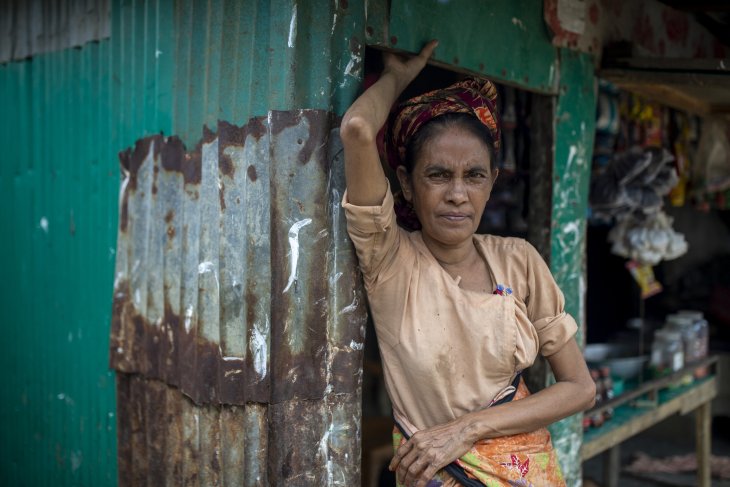“What is happening with the Rohingya refugees? We heard so much about all the horrible things, but how are they now?”
These are questions I often get when I talk to people about my research.

Rohingya refugee woman in front of her shop at Noya Para Rohingya refugee camp in Bangladesh in May 2023. Photo: K M Asad/LightRocket via Getty Images
What is the situation for the Rohingya? The situation is terrible.
I have visited the refugee camps four times over the years and each time I am struck by how much more desperate it has become since the last time I was there.
Six years since the endless stream
Everyone remembers the horrible images. The endless stream of people carrying belongings, children and injured relatives, while the choking smoke, from what had been their villages, billowed from the jungle on the other side of the border.
For weeks, the stream of people continued along the narrow paths between the rice fields in Bangladesh on the border with Myanmar. Almost 800,000 people in just a few months. No one knows for sure how many thousands were killed or died along the way. Last week marked six years since the start of the nightmare.
Life-threatening camps
In the beginning, there was a lack of proper health services, trauma treatment, education and future prospects. This is still critical, but in recent years the camps have also become life-threatening. Criminal gangs are allowed to terrorize the camps and the authorities in Bangladesh have deployed one of their most corrupt police battalions to take care of security. Surveillance, threats, kidnapping, blackmail and murder have become part of everyday life. There is no security for anyone.
Almost daily, I receive messages from refugees I have worked with — young activists who dedicate their lives and all their resources teaching children and young people, working for women’s rights and offering services and help to the most vulnerable. The activists share experiences of threats and persecution, and many have paradoxically had to flee from the refugee camp.
One is isolated with his family in a closed temporary camp due to threats of murder. At first, he escaped the camps only at night, when the murderers operated freely. But lately, the murders are happening in broad daylight, and the UNHCR has isolated him and others in a similar situation. He can’t meet anyone, can’t go anywhere, and he doesn’t know how long he will have to live like this. Nevertheless, he is one of the lucky ones, very few people get this kind of protection.
A young female activist with two small children must care for herself. She has to rent a room in the local community outside of the refugee camp. Every three months, she must move to a new place, while struggling to secure food for herself and her children. She cannot collect her food rations. If she shows up in the camp, she will be killed. This young woman, like so many others, has worked as a volunteer for UN Women and has been an important voice for women’s rights in an oppressive society. Now, her life is threatened and the support she previously received from UN Women is gone.
A third person fled the camp already several years ago and crossed the border into India without valid documents. He was arrested and served his one year’s sentence for illegal border crossing. Now however, almost three years later, he is still in detention in India. He doesn’t know for how long. He is registered as a refugee with the UNHCR in both India and Bangladesh, but there is no help or assistance.
These are just three individuals. I could have listed many more. The last two times I visited acquaintances in the camp, I could see how these resourceful and strong people were about to lose hope. They are exhausted, scared and deeply depressed. Still, they don’t give up. They continue to fight. But they need help.
What is the solution?
Because what is the solution? Myanmar is not safe. Rakhine State, where the Rohingya refugees come from, is a war zone. The aid organizations have cut the food rations from 12 to 8 dollars a month per person. At the same time, Bangladesh is tightening the grip. Tall, barbed wire fences encapsulate the refugee camps. They have been turned into detention camps. No one is safe from landslides and the many arson attacks.
In desperation, many young people pay human traffickers to be transported in overcrowded boats to Malaysia. They end up indebted and in slave labor because they are unable to pay the high fees, often as much as 6000 dollars. Many end their lives at sea.
The situation is critical. Waiting for Bangladesh and Myanmar to agree on a solution for the Rohingya refugees is to run away from responsibility. The UN system and the international community must become far more proactive in solving the crisis — in accepting refugees, providing educational opportunities and to demand that Bangladesh takes care of the security situation. Those who are threatened, must receive protection and the UN organizations must take direct responsibility for the people they work with.
It is challenging, but it is far from impossible.
- Marte Nilsen is a Senior Researcher at PRIO